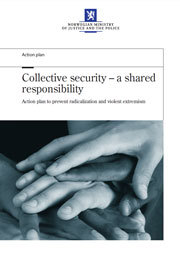Collective security – a shared responsibility
Action plan to prevent radicalization and violent extremism
Plans/strategy | Date: 09/05/2011 | Ministry of Justice and Public Security
Originally published by: Ministry of Justice and the Police
This is Norway’s first action plan for the prevention of radicalization and violent extremism. The plan has been based on four priority areas: knowledge and information,strengthening the authorities’ co-operation, strengthened dialogue and greater involvement and support to vulnerable and at-risk persons.
 | |
| Download the action plan in PDF-format. |
Foreword
Norway is one of the safest countries in the world and creating a safe and secure society is a fundamental aim of every government. Those who choose to use violence and terror cause anxiety and fear and must be fought against and prosecuted. We have a responsibility to take a pre- cautionary approach. Providing protection is also about prevention, both here in Norway and internationally.
Even though the threat level in Norway is considered to be low, the Government has informed the Storting that there are aspects in the situation inside and outside Norway today that collectively represent a transition to a terror threat picture more like the one we see in countries where terror attacks have been or have been attempted to be carried out. We have no guarantee that no serious situations will arise, and the terror threat can change rapidly.
Giving pupils a tour of the Storting’s Eidsvold Gallery clearly demonstrates the fundamental values on which Nor- wegian democracy has been based: popular sovereignty, division of powers and human rights. I usually stress that we must understand and defend the value of having a critical and free press and a broad political and voluntary sector. We must defend these foundation stones of democracy: the rule of law and freedom of expression and speech. The strength of the transparent Norwegian community lies in just this – that everyone shall be allowed to be heard. We must also tolerate views and opinions we do not like to hear and oppose these using democratic methods and intellectual weapons.
One thing is crystal clear: no one must be able to force their views on the majority through use of violence. Those who cross this divide shall be prosecuted and opposed. This requires that we can have two thoughts in our head at the same time. A strong police force and highly competent security services shall protect the population and combat and limit threats of serious crime, as well as use of violence and terror. This lies outside the framework of this plan. This action plan describes the other approach – a concerted effort to prevent first so that violent, extreme views are not translated into actions.
We must do more to prevent undesirable behaviour before it is too late and we must do so in a broad perspective. We must resolve conflicts, rather than aggravate and create new ones and we must choose dialogue rather than creating a divide between individuals and groups. It is through increased democratic participation that we can drive back those who wish to use violence to achieve their political goals. The strength of open democracy is that the majority is always in the majority, that extreme views are in the minority and that even fewer will translate extreme views into actions.
In criminal law, there is an important distinction between views and actions. Violent, extreme actions and terror usually target victims randomly. In combating actions, criminal law has the advantage that criminal liability is individual. Criminal law targets the terrorists themselves and not the groups to which they belong. We must ensure that Norwegian counter-terror measures continue to be targeted, restrictive and responsible. Violent, extreme views have the opposite intention – their targets are deliberately chosen on the basis of race, religion, gender or sexual orientation. We will combat such views with words. Racist and discriminating views must be met on a broad front. This is our joint social responsibility.
It is important to have a critical and knowledge-based debate on one of the most important challenges of our time. Politicians, the media and experts have a joint responsibility to avoid simplifications, fear and generalizations associated with the threat that someone will use violence and terror to achieve their goals.
If we choose to use simplified enemy images when establishing a threat picture and our policies, we will end up with a simplified threat picture and simplified policies. This will not be effective enough in an increasingly complex world and will be a weak policy for the prevention of violent extremism and terror. We must have a comprehensive policy based on sound analyses, thorough nuances and that is generally knowledge-based.
I hereby present Norway’s first action plan for the prevention of radicalization and violent extremism. This plan has been based on four priority areas: knowledge and information, strengthening the authorities’ co-operation, strengthened dialogue and greater involvement and support to vulnerable and at-risk persons.
This plan is a tool for responsible authorities in all areas. I would like to give special thanks to everyone from the knowledge centres, organizations, the ministerial community and the justice sector that have contributed with good advice and input to the work on this action plan. Our collective security is a joint responsibility.